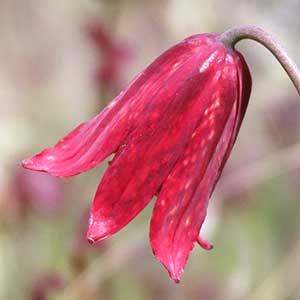Fritillaria camschatcensis
Fritillaria gentneri
black lily, Indian rice, Kamchatka fritillary, northern rice-root, rice-root fritillary
Gentner's fritillary
large 6–15; small 30–190.
large several; small numerous.
2–6 dm.
5–7 dm.
in 1–3 whorls of 5–9 leaves per node proximally, alternate distally, 4–10 cm, usually shorter than inflorescence;
blade narrowly to broadly lanceolate;
distal leaves usually ± equaling proximalmost leaf.
in 1–3 whorls of 3–5 leaves per node proximally, alternate distally, 7–15 cm;
blade broadly linear to lanceolate.
spreading to nodding, odor unpleasant;
tepals dark greenish brown to brownish purple, sometimes streaked or spotted with yellow, oblong-elliptic to elliptic-obovate, 2–3 cm, apex not recurved;
nectaries obscure, same color as tepals, linear, ± equaling tepal length;
style obviously branched for 2/3 its length, branches longer than 1.5 mm.
spreading to nodding;
perianth broadly campanulate;
tepals red to purple, clearly mottled with yellow, 3.5–4 cm, apex spreading, not recurved;
nectaries linear, 1/2 tepal length;
style obviously branched for 1/3–1/2 its length, branches widely spreading, longer than 1.5 mm.
cylindric-ovoid.
winged.
= 24, 36.
Fritillaria camschatcensis
Fritillaria gentneri
Coastal Native Americans used bulbs of this species for food. Often the bulbs were dried and later added to other foods, especially soups and fish dishes.
(Discussion copyrighted by Flora of North America; reprinted with permission.)
Of conservation concern.
Fritillaria gentneri is a restricted endemic closely allied with F. recurva and F. affinis, with which it can be confused. Some evidence suggests that it may represent a hybrid between those two species. More study is needed to determine whether it should remain recognized as a distinct species.
(Discussion copyrighted by Flora of North America; reprinted with permission.)


